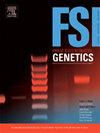英国家犬(Canis lupus familiaris)种群的特征识别目的使用法医验证的13常染色体STR标记集
IF 3.1
2区 医学
Q2 GENETICS & HEREDITY
引用次数: 0
摘要
在英国,犬类的证据目前还没有得到充分的调查,部分原因是缺乏全面的基因数据库,无法阐明构成犬类种群的高度近亲繁殖品种的复杂性。这里的研究建议使用CaDNAP标记,一种经过法医验证的面板,应用于更广泛的英国犬群。为此,对1200多只狗进行了80个品种的13种STRs基因分型。为了建立一个更可靠的全英国犬类等位基因频率数据库,已经研究了数学修正,以解决英国犬种分布不均匀的问题。此外,对最常见品种的选择(11)进行了进一步的研究,以建立特定品种的等位基因频率数据库,以便在已知感兴趣的动物品种的情况下产生更准确的匹配概率。对这两组频率的应用都进行了仔细审查,以评估它们在实地的适用性,并与欧洲大陆现有的数据库进行了比较。建议在从全国等位基因频率数据库估计直接匹配似然比时,使用最小FST校正0.2。本文章由计算机程序翻译,如有差异,请以英文原文为准。
Characterisation of the UK domestic dog (Canis lupus familiaris) population for identification purposes using a forensically validated set of 13 autosomal STR markers
Canine evidence in the UK is currently not being fully investigated, partly due to the lack of comprehensive genetic databases that are able to clarify the complexity of the highly inbred breeds that make up the canine population. The study here proposes the use of the CaDNAP markers, a forensically validated panel, to be applied to the wider UK canine population. For this purpose, over 1200 dogs have been genotyped for 13 STRs, belonging to 80 breeds. Mathematical corrections have been investigated to address the uneven breed distribution in the country in order to produce a more reliable allele frequency database for the whole UK canine population. In addition, a selection of the most common breeds (11) has been further investigated to produce allele frequency databases that are breed-specific with the aim of producing more accurate match probabilities should the breed of the animal of interest be known. The application of either set of frequencies has been scrutinized to evaluate their applicability in the field and are compared to current databases available in mainland Europe. A recommendation is made to use a minimum FST correction of 0.2 when estimating direct match likelihood ratios from whole country allele frequency databases.
求助全文
通过发布文献求助,成功后即可免费获取论文全文。
去求助
来源期刊
CiteScore
7.50
自引率
32.30%
发文量
132
审稿时长
11.3 weeks
期刊介绍:
Forensic Science International: Genetics is the premier journal in the field of Forensic Genetics. This branch of Forensic Science can be defined as the application of genetics to human and non-human material (in the sense of a science with the purpose of studying inherited characteristics for the analysis of inter- and intra-specific variations in populations) for the resolution of legal conflicts.
The scope of the journal includes:
Forensic applications of human polymorphism.
Testing of paternity and other family relationships, immigration cases, typing of biological stains and tissues from criminal casework, identification of human remains by DNA testing methodologies.
Description of human polymorphisms of forensic interest, with special interest in DNA polymorphisms.
Autosomal DNA polymorphisms, mini- and microsatellites (or short tandem repeats, STRs), single nucleotide polymorphisms (SNPs), X and Y chromosome polymorphisms, mtDNA polymorphisms, and any other type of DNA variation with potential forensic applications.
Non-human DNA polymorphisms for crime scene investigation.
Population genetics of human polymorphisms of forensic interest.
Population data, especially from DNA polymorphisms of interest for the solution of forensic problems.
DNA typing methodologies and strategies.
Biostatistical methods in forensic genetics.
Evaluation of DNA evidence in forensic problems (such as paternity or immigration cases, criminal casework, identification), classical and new statistical approaches.
Standards in forensic genetics.
Recommendations of regulatory bodies concerning methods, markers, interpretation or strategies or proposals for procedural or technical standards.
Quality control.
Quality control and quality assurance strategies, proficiency testing for DNA typing methodologies.
Criminal DNA databases.
Technical, legal and statistical issues.
General ethical and legal issues related to forensic genetics.

 求助内容:
求助内容: 应助结果提醒方式:
应助结果提醒方式:


